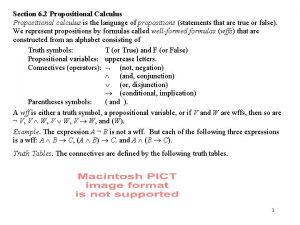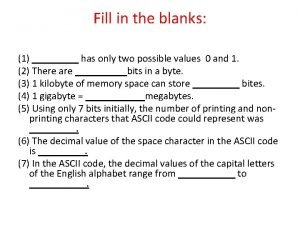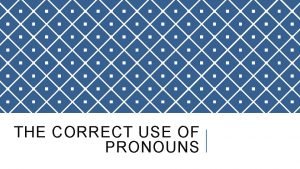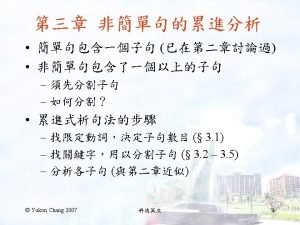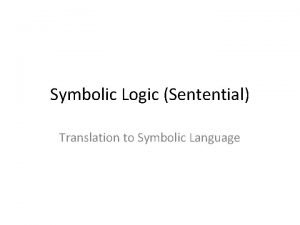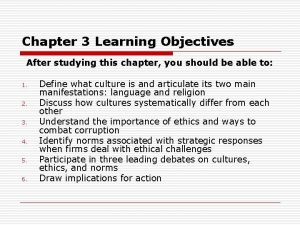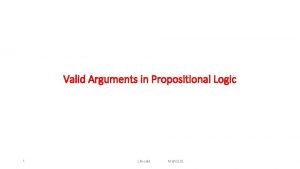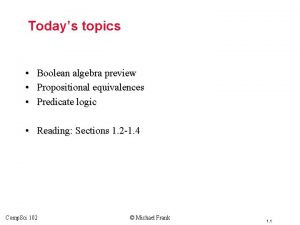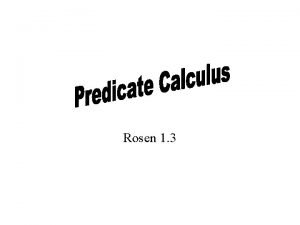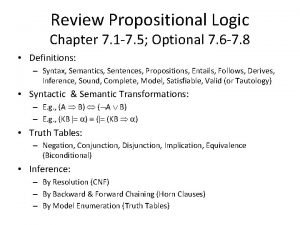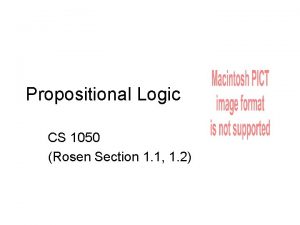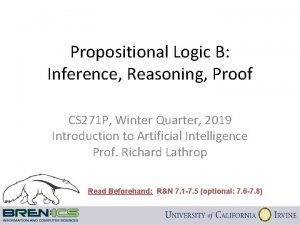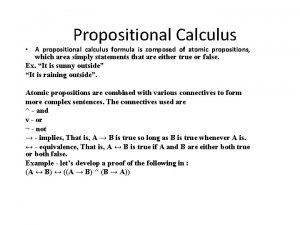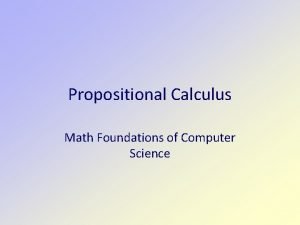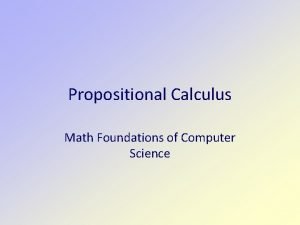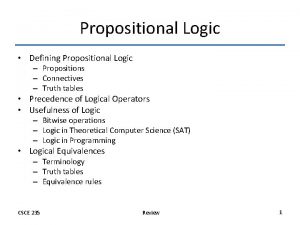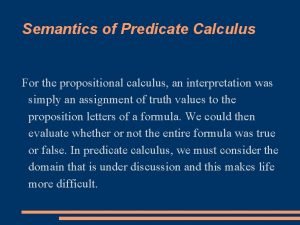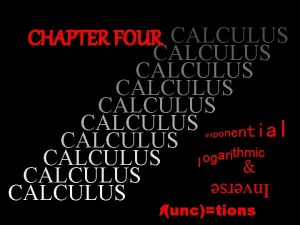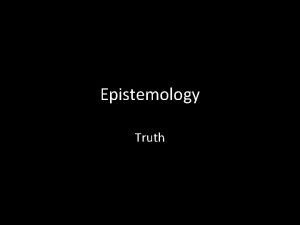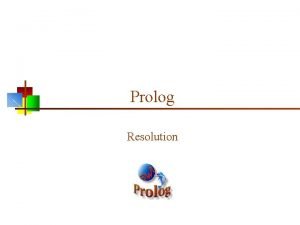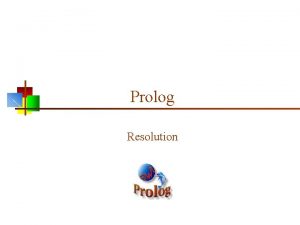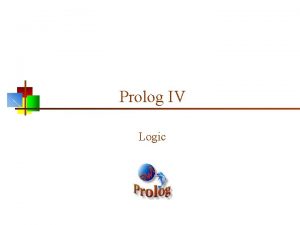Propositional Calculus There are only two truth values






















- Slides: 22

Propositional Calculus • There are only two truth values, true and false • Variables are typically represented by upper case letters • Commonly used connectives – negation, – and (conjunction), – or (disjunction), – implication, – equivalence, = • Legal sentences are well-formed formulas, such as

Proving a Sentence is True • The sentence is true. Prove this using truth tables.

Semantics • The following laws can be shown to be true by using truth tables

De. Morgan’s Law • Prove De. Morgan’s law (P Q) = ( P Q) by constructing an appropriate truth table

Predicate Calculus • Symbols – true and false – constants, start with lowercase letter – variables, start with uppercase letter – functions start with a lowercase and many have an “arity”, that is an attached list of elements in parentheses • Examples – mother(mary, bill) – father(bill, george) – likes(jim, X) – father(X, Y)

Qualifiers • Universal qualifier, X mortal(X) Y likes(bill, Y) • Existential qualifier, Y likes(bill, Y) Z mother(Z, george) • A complex sentence Write this as an everyday English sentence.

Interpretation of sentences • If D is a nonempty set of values each constant has a value from D each variable has a set of allowable substitutions each function f with arity m defines a mapping from Dm into D each predicate p with arity n defines a mapping from Dn into {T, F}

First Order Predicate Calculus • In the first-order predicate calculus, quantified variables cannot refer to predicates or functions – X likes(bill, X) is allowed – Likes X Likes(bill, X) is not allowed • Some relationships in the predicate calculus between quantifiers Give an “everyday” sentence illustrating each of these rules.

Converting Quantifies • X p(X) = X p(X) • Provide an “informal” proof that this equivalence is true

Examples • Translating English sentences into the predicate calculus • A classic example the Blocks World Write these two rules in simple English that a 5 th grader would understand.

Inference Rules • Classic example, given the conclusion using modus ponens • An inference rule is sound if every sentence produced by the inference rule operation on S logically follows from S • An inference rule is complete if it can produce every expression that logically follows from S • Two logic systems that are sound and complete – Moden Ponens, developed by the Greeks, is covered in this chapter – Resolution, developed in the 1960 s, is covered in Chapter 12

Another Modus Ponens • If 20 th day of the month is on Tuesday, then the 22 nd day of the month must be on a Thursday. • President Bush gives the state of the union address to a joint session of Congress on Tuesday, January 20, 2004. • What can we conclude?

Modus Tolens - 1 • Modus Tolens has the form: P => Q and not Q therefore not P • Translate the following sentence into the predicate calculus: I carry an umbrella only when it rains. If it rains it is cloudy. Today is not cloudy.

Modus Tolens - 2 • Given “I carry an umbrella only when it rains. If it rains it is cloudy. Today is not cloudy", use a truth table to prove "I am not carrying an umbrella" is true • HINT: show that the three given predicates ANDed with the NOT of the conclusion is always false and therefore the conclusion must be true.

Some Definitions

Classical Proof Methods • We have already seen examples of modus ponens and modus tolens • Give some everyday examples of AND elimination, AND introduction, and universal instantiation

Unification • Assume foo is defined as foo(X, a, goo(Y) ) • Some example unifications • and the results

Unification Algorithm • Syntax for predicates • A unification algorithm

A Simple Resolution Proof • Given If it is raining, then it must be cloudy. It is not cloudy today. • Using modus tolens we would conclude it is not raining today. • Using resolution proof we first negate what we want to prove and then show this leads to a contradiction. • So we have raining(X) => cloudy(X) cloudy(today) raining(today) // negation of // conclusion

Resolution Proof Tree raining(X) => cloudy(X) raining(today) X today cloudy(today) nil (contradiction)

A Financial Application • Expressed in the predicate calculus

Finding an Investment • Use the previous set of data and assume that minsavings(X) = 5000 * X minincome(X) = 14000 + (4000 * X) • Trace through the unifications of various rules to show that this logical database yields investment(combination)
 Mikael ferm
Mikael ferm Propositional calculus
Propositional calculus A bit can only have the value of 0 or 1
A bit can only have the value of 0 or 1 Subject verb agreement purdue owl
Subject verb agreement purdue owl Singular and plural pronouns chart
Singular and plural pronouns chart There are two things that are infinite
There are two things that are infinite Symbolic logic translation examples
Symbolic logic translation examples Necessary and sufficient conditions examples
Necessary and sufficient conditions examples I only wrote the truth
I only wrote the truth The greatest gift of easter is hope
The greatest gift of easter is hope Western values vs eastern values
Western values vs eastern values Machavillian
Machavillian An individual's enduring tendency to feel
An individual's enduring tendency to feel Explain the concept of human value
Explain the concept of human value Take only photos leave only footprints
Take only photos leave only footprints Arguments in logic
Arguments in logic Propositional equivalences
Propositional equivalences Propositional network
Propositional network Propositional function examples
Propositional function examples Propositional logic examples
Propositional logic examples Well formed formula
Well formed formula Xor in propositional logic
Xor in propositional logic Propositional logic notation
Propositional logic notation

